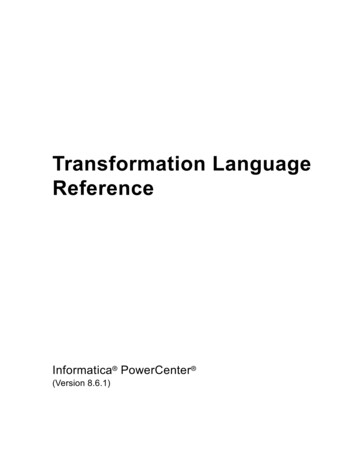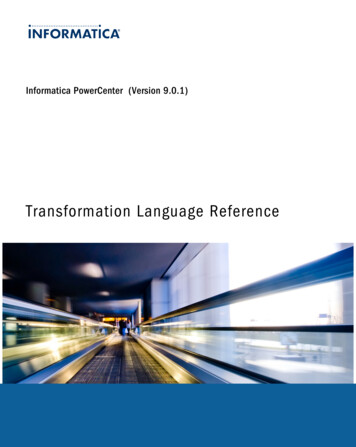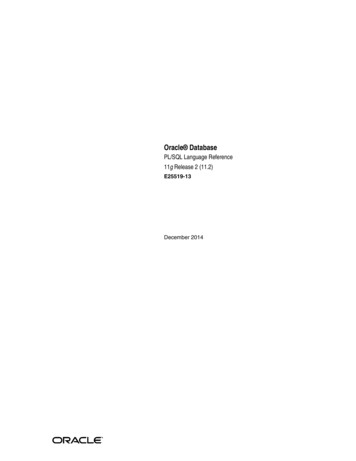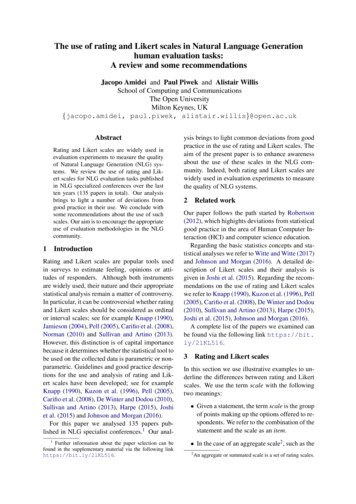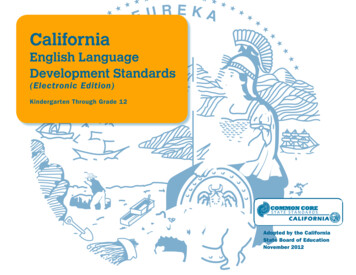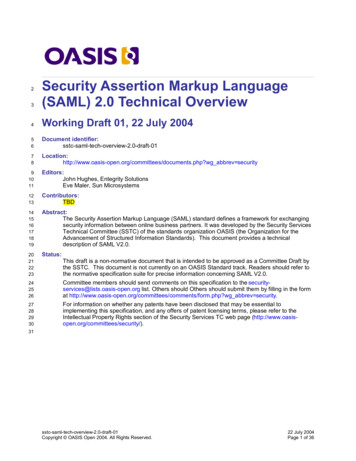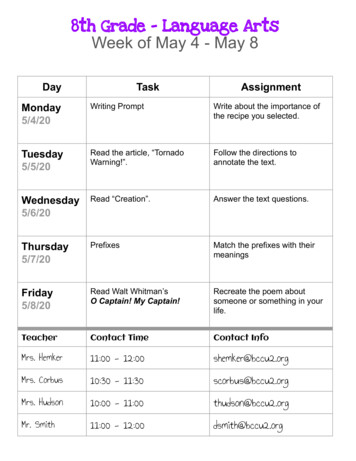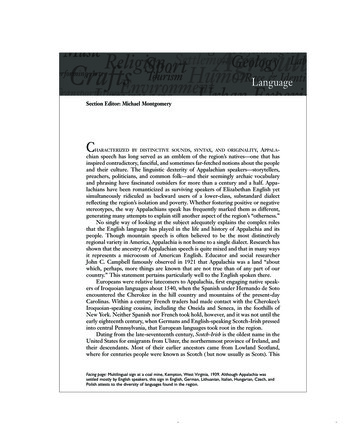
Transcription
19-T3212-LAN 11/2/05 3:30 PM Page 999LanguageSection Editor: Michael MontgomeryC,,, Achian speech has long served as an emblem of the region’s natives—one that hasHARACTERIZED BY DISTINCTIVE SOUNDS SYNTAX AND ORIGINALITYPPALAinspired contradictory, fanciful, and sometimes far-fetched notions about the peopleand their culture. The linguistic dexterity of Appalachian speakers—storytellers,preachers, politicians, and common folk—and their seemingly archaic vocabularyand phrasing have fascinated outsiders for more than a century and a half. Appalachians have been romanticized as surviving speakers of Elizabethan English yetsimultaneously ridiculed as backward users of a lower-class, substandard dialectreflecting the region’s isolation and poverty. Whether fostering positive or negativestereotypes, the way Appalachians speak has frequently marked them as different,generating many attempts to explain still another aspect of the region’s “otherness.”No single way of looking at the subject adequately explains the complex rolesthat the English language has played in the life and history of Appalachia and itspeople. Though mountain speech is often believed to be the most distinctivelyregional variety in America, Appalachia is not home to a single dialect. Research hasshown that the ancestry of Appalachian speech is quite mixed and that in many waysit represents a microcosm of American English. Educator and social researcherJohn C. Campbell famously observed in 1921 that Appalachia was a land “aboutwhich, perhaps, more things are known that are not true than of any part of ourcountry.” This statement pertains particularly well to the English spoken there.Europeans were relative latecomers to Appalachia, first engaging native speakers of Iroquoian languages about 1540, when the Spanish under Hernando de Sotoencountered the Cherokee in the hill country and mountains of the present-dayCarolinas. Within a century French traders had made contact with the Cherokee’sIroquoian-speaking cousins, including the Oneida and Seneca, in the foothills ofNew York. Neither Spanish nor French took hold, however, and it was not until theearly eighteenth century, when Germans and English-speaking Scotch-Irish pressedinto central Pennsylvania, that European languages took root in the region.Dating from the late-seventeenth century, Scotch-Irish is the oldest name in theUnited States for emigrants from Ulster, the northernmost province of Ireland, andtheir descendants. Most of their earlier ancestors came from Lowland Scotland,where for centuries people were known as Scotch ( but now usually as Scots). ThisFacing page: Multilingual sign at a coal mine, Kempton, West Virginia, 1939. Although Appalachia wassettled mostly by English speakers, this sign in English, German, Lithuanian, Italian, Hungarian, Czech, andPolish attests to the diversity of languages found in the region.
19-T3212-LAN 11/2/05 3:30 PM Page 10001000gLanguagehistorical fact is preserved in Scotch-Irish, a name Americans have continued toemploy. Also ( but much less often) known as the Scots-Irish, most of the 150,000 ormore Ulster emigrants who came in the American colonial period settled in the interior, where they and their culture and language became influential in much of Appalachia. Because Scotch-Irish has been the more common name for three centuries andremains so among descendants in Appalachia, it is used in this section in observanceof the linguistic right a group has to name itself.In the nineteenth century, small groups of Welsh, French, and other Europeansalso came to Appalachia, but only English and German ever became communitylanguages. The latter declined precipitously in the twentieth century, as did nativelanguages. In modern Appalachia, English is known by all except for very recentmigrants (such as Mexicans in north Georgia), though misconceptions, myths, andmisinformed stereotypes about its speakers abound.Indeed, the English language in Appalachia has long captivated journalists,travelers, and educators, and since the 1880s they have stressed one quality above allothers—its conservatism. Writers have consistently been struck by the older usagesretained in the mountains. An early and still frequent explanation for these archaicelements was that mountain speech was “Elizabethan” or “Shakespearean.” Suggestions of such respectable roots have largely been discredited, though, and Appalachian speech is more often considered an inferior type of English and therefore animpediment to social mobility and educational progress. These conflicting viewshave simultaneously romanticized mountain speech (and by implication its users) asquaint while stigmatizing it as improper and ungrammatical. The public, scholarsincluded, appears to have no difficulty holding contradictory ideas about the Englishlanguage spoken in Appalachia.Influenced by early backwoods humorists’ use of dialogue, nineteenth- and earlytwentieth-century writers such as humorist George Washington Harris and novelistMary Noailles Murfree created generally negative images through their fictional portrayals of mountain speakers. Both employed contorted spellings to enhance theirportrayals of illiterate, dialect-speaking characters. “Thar’s nun ove ’em fas’ enuf tuketch me” is typical dialog from one of Harris’s mountain characters. Many of theseforms later made their way into the Barney Google comic strip after Snuffy Smith wasintroduced to it in 1934. Reinforcing this stereotypical image since that time havebeen countless books, movies, television programs, and tourist-shop caricatures conveying the popular but erroneous belief that such usages as plumb “completely,” asin “He fell plumb to the bottom,” and right smart “a good deal (of),” as in “They losta right smart in that trade,” among others, are found only in mountain speech.No matter how ludicrous, portrayals of mountain English in the media are oftenconsidered accurate outside Appalachia and consequently reinforce perceptions thatmountain people are different and backward.Writers have also pointed out the expressiveness and adaptability of mountainspeech and the resourcefulness of its speakers, however. These positive qualities areappreciated in fresh metaphors such as kick “reject in courtship” and can see to can’tsee “dawn to dusk”; vivid similes (meaner than a striped snake; as thick as fiddlers in hell);abundant use of proverbs; descriptive place names such as Hell for Certain, Kentucky; novel conversions of one part of speech to another (the noun manpower as averb meaning “move by brute effort,” as in “We’ll have to manpower that log up”);and in other ways.Because the Appalachians cover a vast area from the Northeast to the DeepSouth, the region is too large to form a distinct or unified region in traditional cul-
19-T3212-LAN 11/2/05 3:30 PM Page 1001Languageture or speech. Instead, linguists focus on the Midland dialect region, a smaller areastretching westward and southwestward from its cultural and linguistic seedbed incentral Pennsylvania, where English was first planted in the region, to northern Alabama. This region is subdivided into the North Midland (northern West Virginia,northwestern Maryland, and most of Pennsylvania) and the South Midland (southern West Virginia, western Virginia, western North and South Carolina, easternKentucky, east Tennessee, north Georgia, and north Alabama).Several factors worked against Appalachia’s becoming a distinct, cohesive dialectarea of its own. Settlement by different groups or different proportions of groupsproduced local variations within the region. Migration within the region has mixedthe languages of the English, Scotch-Irish, Germans, and other settler groups in various ways, leveling differences in their speech and spawning innovations. Researchby the American Linguistic Atlas Project, a systematic national survey of traditionalvocabulary initiated in the 1930s, found only seventeen words and phrases by andlarge distinctive to the Midland region. Some of these are bawl “a calf ’s cry”; blinds“window shutters”; hull “to shell,” as in “to hull beans or peas”; and poke “paper bag,”as in “She bought a poke of peanuts.” Six others are common to the North Midland( jag “armful of corn”; run “creek”) and five ( jacket “vest”; fireboard “mantel,” as in“Lydia set her clock proudly on the fireboard”) to the South Midland.Another survey, conducted in the 1960s in connection with the Dictionary ofAmerican Regional English, found four strictly Appalachian terms: spring house “smallbuilding over a spring in which to keep foodstuffs cool,” as in “Pickled beans andkraut were kept in the spring house”; poke “paper bag”; whistle pig “groundhog”; andlay out “to play truant from work or school.” Since then, the dictionary has labeled46 items “Appalachian” and 123 others “southern Appalachian” because they appearto be concentrated in those regions. Interestingly, the dictionary labels some itemsas “now Appalachian,” including gaum “a mess,” as in “He left everything in agaum.” This suggests that much of what is popularly thought to be Appalachian issimply disused, old-fashioned English outside the region.This scarcity of evidence for geographically defined Appalachian English has ledsome scholars to consider whether such entities as “Appalachian English” and“Southern Appalachian English” exist or whether they are more strongly linked tocultural solidarity than geography and common usage. Mountain people’s strongsense of place, cohesive communities, and attachments to traditional lifestyles and values, it is believed, make them less willing to change or accommodate to mainstreamculture. This resistance to change is reflected in the tendency to retain speech habits,even a generation or more after a person has moved to a metropolitan area such asChicago, Detroit, or Cincinnati. Like people who stayed back home, these migrantsoften consciously distinguish themselves from people outside their communities, asin pronouncing Appalachia with the third syllable as latch rather than lay, a development that has grown steadily since the 1960s and reflects regional consciousness anda reaction to the pronunciation of members of the media and government officials.The existence of many archaisms in mountain speech has prompted more studyof its origins than that of any other regional American English variety. Three sourcesof origin are commonly proposed: that these archaisms are traceable mainly to Elizabethan England, to eighteenth-century colonial America, or to Ulster ( by way of theScotch-Irish). It is easy to oversimplify this issue because no type of speech came toNorth America without mixing with others immediately after arrival, because retentions represent only part of the larger history of mountain speech, and because notype of American English, no matter how isolated, has remained static.g1001
19-T3212-LAN 11/2/05 3:30 PM Page 10021002gLanguageThe Elizabethan, or Shakespearean, connection is the most popular but has theleast historical and linguistic support. People from the British Isles who settled inAppalachia began arriving in North America more than a century after the Elizabethan period of the late sixteenth century. Furthermore, the source of most Appalachian vocabulary has been Britain in general (not just England) and to a lesserextent northern England (galluses “suspenders”; palings “fence posts”), western England (counterpane “bedspread,” as in “We sleep under a counterpane”), and Scotland(chancy “doubtful,” as in “Hit was a chancy sort of thing to do”; sop “gravy,” as in “Weate light bread and sop”).The myth of Elizabethan English was formulated and promoted by people fromareas outside the Appalachians who recognized some mountain usages (afeared“afraid,” as in “He wasn’t afeared of them in the least bit”) as being also in the worksof Shakespeare. Some came to know mountain people firsthand, and they attemptedto counter negative stereotypes by highlighting their positive qualities. Although thisElizabethan connection has little scholarly basis, it and related ideas have flourishedas cultural myths, possibly because the region retains immense value for countlessAmericans elsewhere who lack cultural roots. They view the language and culture—and especially the music—of Appalachia as valuable storehouses of tradition, lessaffected by mass society and more closely tied to the past. Historically, however, thisromantic notion has not saved Appalachia from neglect, marginalization, and exploitation by the rest of the nation.For both pronunciations and grammar patterns a better case can be made forcolonial American than for English roots. For example, blowed and knowed as the pasttense and past participle of blow and know do not occur in Shakespeare but were fairlycommon among eighteenth-century English immigrants to the American colonies.The use of these verb forms is still common in Appalachia, though they have longbeen considered nonstandard in the United States. Such colonial American forms inmountain speech are far more numerous than supposed Elizabethan ones.Associated with both of these explanations is the alleged influence of geographicand cultural isolation on Appalachian speech. This is largely a myth, based on thefalse beliefs that Appalachia is culturally homogenous and that physical isolationcaused life in the mountains to move slowly, even to become frozen in time. Archaicspeechways, along with traditional ballads, Jack tales, folk dancing, and weaving,supposedly prove that Appalachian culture is static. Historians have pointed out thatmountain communities are quite typical of rural America, however, and while thesetraditions might seem perfect examples of cultural preservations from centuries past,studies have found them to be living and dynamic. Mountain people still write ballads to recount modern tragedies, disasters, and star-crossed love, but these are timeless themes, not archaic ones.The third commonly cited origin of Appalachian speech is that it derives mainlyfrom people from Ulster, the Scotch-Irish. Most of the 150,000 or more emigrantswho left Ulster in the eighteenth century settled in the American interior, becomingknown as Scotch-Irish. Many of them moved into the hills and valleys of Appalachia,but only traces of modern-day Appalachian pronunciation are attributable to them.In vocabulary a few Scotch-Irish contributions to the region are airish “chilly,” as in“It was an awful airish day”; brickle “brittle,” as in “The dry leaves were brickle andcrumbled easily”; discomfit “to inconvenience,” as in “I wouldn’t want to discomfityou”; and ill “bad-tempered,” as in “That dog is ill as a hornet.”The Scotch-Irish contribution to regional grammar has been even more significant, as evidenced in the formation of words ( by combining ’un “one” with adjec-
19-T3212-LAN 11/2/05 3:30 PM Page 1003Languagetives and pronouns, as in “young’un,” “big’un,” and “you’uns”); phrases (need followed by a verb past participle, as in “That boy needs taught a lesson”); compoundhelping verbs (“I wonder if you might could help me”); and clauses (whenever for “atthe time that,” as in “Whenever I was young, people didn’t do such a thing”). TheEnglish of Appalachia resembles the language of Shakespeare’s England not nearlyso much as that of eighteenth-century Ulster.Even so, only about 20 percent of Appalachian pronunciations, vocabulary, andgrammatical patterns not shared by the rest of the nation can be traced to the BritishIsles. This percentage is higher than for most other varieties, but it indicates that theforemost component of American speech in general, and Appalachian speech in particular, is new vocabulary. Borrowings and inventions are continually needed as speakers face new challenges of environment and culture.Most terms identified as Appalachian by the Dictionary of American Regional English and other sources were actually born in America (bald “treeless area on a mountaintop”; flannel cake “pancake”). Of the seventeen Midland items identified by theAmerican Linguistic Atlas Project, most are unambiguously American in origin andrepresent responses to the New World (lamp oil “kerosene”; sugar tree “sugarmaple”). Six at most ( piece “snack”; want in “want to go/come in,” as in “That dogdoesn’t know whether he wants in or out”) may have come from Ulster (thoughmuch of the English of Ulster is shared with northern England and Scotland and is,historically speaking, derived from those regions).Contributions to Appalachian speech from other languages have beeninsignificant. Other than many surnames in the region, few linguistic traces of German exist outside Pennsylvania, where the language shows in words such as smearcase“cottage cheese,” from German schmier “spread” and Käse “cheese.” Irish Gaelic/Scottish Gaelic inheritance is also scant and consists mainly of vocabulary. Termssuch as brogan “heavy, homemade leather shoe,” bonny clabber “curdled sour milk,”and muley “hornless cow,” as in “Let’s get our muley cow from the field,” already hadbeen absorbed by the English-speaking Scotch-Irish before they left Ulster, and noevidence for a community of Gaelic speakers in Appalachia has been documented.Other European languages such as Spanish (doney “sweetheart”) and French contributed even less to Appalachian speech. The lack of influence from Cherokee is bothstriking and puzzling. Because so much medicinal and other lore was borrowed bywhites from the Cherokee in southern Appalachia, as well as the names of so manyrivers, mountains, and other topographical features, there is no ready explanation forthe absence of common vocabulary such as Cherokee names of plants.Many features of grammar and pronunciation are also found elsewhere, especially in the Deep South, but occur with a higher frequency in Appalachian English,distinguishing it from other varieties. Some of these common grammatical patterns,such as a- as a prefix on verb present participles (a-goin’; a-comin’) and possessive pronouns with the suffix -n (hern; hisn; yourn, as in “a book of yourn”), came from England. Emigrants from Ulster introduced others, such as personal pronouns hit “it”and you’uns “you (plural)” and all after pronouns to indicate inclusion: who all andwhat all, as in “Who all came and what all did they say?”Verbs with the same form for the past tense and past participle as wellas present tense (come; eat; run) and the addition of -est to form the superlativeof adjectives ending in -ing (workingest “working the hardest or most,” as in “theworkingest fellow in town”; singingest) exhibit a general ancestry from the BritishIsles, while the reversal of word elements (everwhat “whatever”; everwho “whoever,”as in “Everwho hears that will be surprised”) and the use of prepositions in seriesg1003
19-T3212-LAN 11/2/05 3:30 PM Page 10041004gLanguage(“There was several houses on up around on Mill Creek”) are apparently Americandevelopments.Many common patterns of pronunciation reflect the general English of colonialdays. These include final -a pronounced as -y (opry “opera”; extry “extra,” as in “Thesoup needs an extry pinch of salt”) and heavy use of r, including addition of the soundto some words (mater “tomato”; warsh “wash”).Other pronunciations are more recent developments shared with the DeepSouth: prolonging and splitting of vowels into two syllables (red as re-uhd or ray-uhd;rib as ri-uhb, a pattern sometimes known as the “southern drawl”); shifting of accentto the first syllable of a word (IN-surance; PO-lice); modification of “long i ” to ah incertain contexts, so that my right side sounds like mah raht sahd, wire rhymes witheither car or war, and tile rhymes with tall; and pronouncing the same vowel soundin word pairs such as pen/pin and gem/Jim.Mountain speech has retained or created senses of words unfamiliar elsewherein the United States that can result in miscommunication. In the Great SmokyMountains someone might be heard to say, “A lot of mountain people are kind ofbackward, but I don’t care to talk to nobody.” By this is meant that while others areshy, the speaker does not mind (in fact, enjoys) talking to strangers. If someone saysthey are “hard to hear,” they may mean, depending on the context, that they havedifficulty hearing others, as well as that they are soft-spoken. Other common wordshaving variant meanings in the mountains include several “quite a few,” as in “Wepicked several blackberries this summer,” clever “hospitable,” as in “You’ll findpeople very clever here in the mountains,” and ill “bad-tempered.”Many social factors influence the use of Appalachian speech by individuals: formality of a given situation, respective ages and occupations, level of education, andso on. Less educated working-class speakers are more likely to use speech consideredtypically Appalachian, though some features of pronunciation are used at all socialor educational levels (except in northern parts of Appalachia). Examples includemodification of “long i ” to ah in words like time and my and the pronunciation ofwords like pen and gem as pin and Jim. These are completely “standard” in Appalachia and in much of the South.Vocabulary varies mainly by subregion within Appalachia or by the age or “ruralness” of the speaker. More modern, national terms have been rapidly displacingolder, rural counterparts, especially among younger inhabitants. A recent study ofstudents at a small western North Carolina college found a dramatic loss of regionalvocabulary; for instance, living room, gutters, mantel, and attic had completely replacedbig house, eaves trough, fireboard, and loft.Because it brings speakers into contact with national norms, formal educationenables speakers, especially younger ones, to shift between varieties of Englishaccording to a given situation. But it also produces self-consciousness or defensiveness about differences between their “home English” and “school English,” pittingthe values of family and place against the larger world and striving for the mobilityto enter it. Because of the pressure to conform to local norms in much of rural Appalachia, an individual’s level of education often does not strongly influence the way heor she speaks.Too often one still finds the view that American dialects such as Appalachianspeech are only modifications of Standard English “incorrectly learned” due to socialbackwardness or even mental deficiency. Educators and linguists have argued againstthese views for a long time, but the association of mountain English with impoverished, low-status speakers has resisted arguments of its respectable heritage. Unfor-
19-T3212-LAN 11/2/05 3:30 PM Page 1005Languagetunately, some mountain people also have accepted this negative evaluation of theirEnglish.No region, community, or person is uniform in speech, of course. Variation andchange in languages are natural and universal. In Appalachia, language has beenshaped by the region’s history of frontier settlement, its geographic breadth, thediversity of peoples and cultures coming in contact there, and the constant adaptation by speakers to meet their needs. Like other types of American speech, languagein Appalachia will continue to bend somewhat to the forces standardizing Americanculture. But in the end, it will persist because of the strong cultural cohesion and thesense of social and regional identity it provides to its speakers, even in the face ofmisunderstanding and pressure to conform.—Michael Montgomery, University of South CarolinaCraig M. Carver, American Regional Dialects: A Word Geography (1987); Frederic G. Cassidy et al., eds.,Dictionary of American Regional English (1985– ); Hans Kurath, A Word Geography of the Eastern UnitedStates (1949); Michael Montgomery, “How Scotch-Irish is Your English?” Journal of East Tennessee History(1995) and “Myths: How a Hunger for Roots Shapes Our Notions about Appalachian English,” Now andThen (Summer 2000); Michael Montgomery and Joseph S. Hall, Dictionary of Smoky Mountain English(2004); Anita Puckett, Seldom Ask, Never Tell: Labor and Discourse in Appalachia (2000); Walt Wolfram andDonna Christian, Appalachian Speech (1976).g1005
Language g 1001 19-T3212-LAN 11/2/05 3:30 PM Page 1001. The Elizabethan, or Shakespearean, connection is the most popular but has the . Elizabethan connection has little scholarly basis, it and related ideas have flourished . romantic notion has not sa




